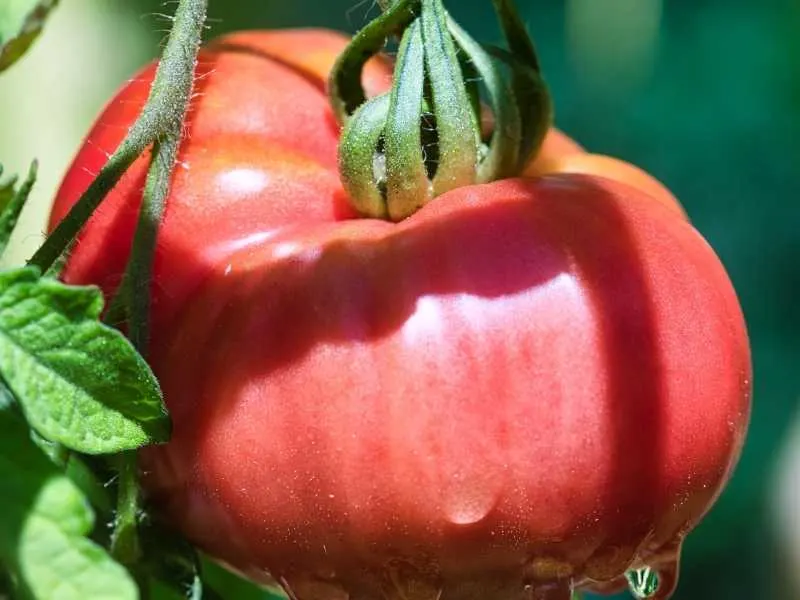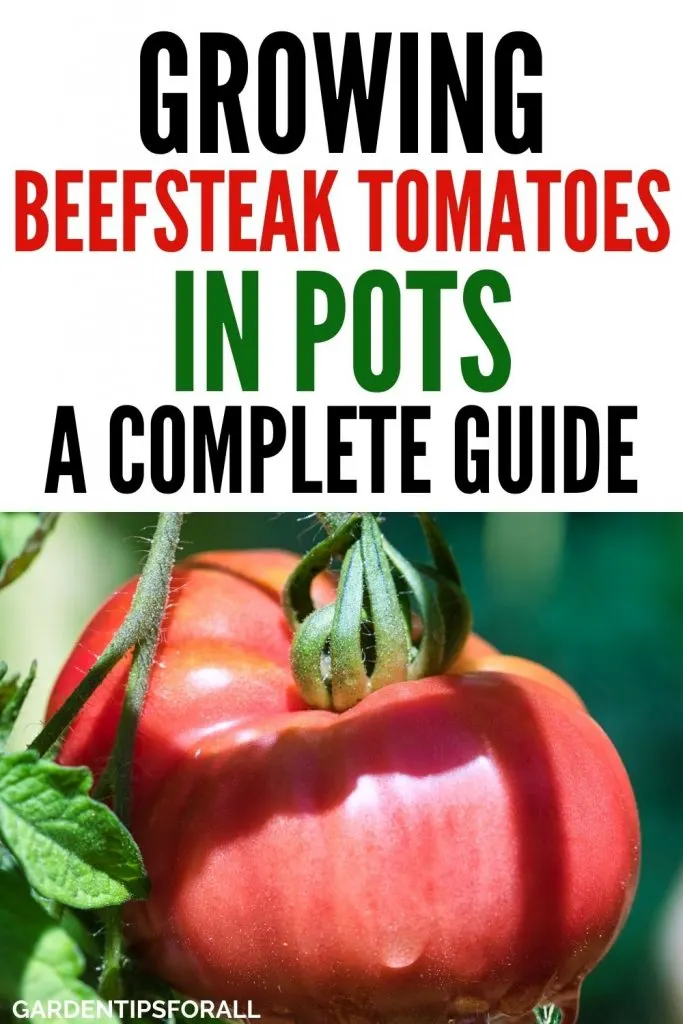How to Grow Beefsteak Tomatoes in Pots – The Ultimate Guide!
Growing beefsteak tomatoes in pots is one of the easiest ways to start container gardening. And a container garden helps you to maximize your available space.
Beefsteak tomatoes are one of the most popular tomato varieties; they also produce very large fruits that weight about 2 pounds. Moreover, they are relatively easy to grow.
They come in vibrant red or pink color, and better yet, they are quite juicy.
And growing beefsteak tomatoes in pots means that you don’t really need a large portion of land to do so. It also means you can start your own small container garden in your backyard or grow beefsteak tomatoes indoors.

Why Grow Beefsteak Tomatoes in Pots?
Tomatoes love warm weathers. And growing tomatoes in a pot gives you an edge.
Why? Because it allows you to easily transport your tomatoes inside whenever it snows to prevent frost damage.
On the other hand, if you are growing your tomatoes in a garden setting, you can only spray the crops and pray to the high heavens that their beefsteak tomatoes withstand the terrible weather.
Another great thing about potted tomatoes is that you can easily use LED lights to warm your tomatoes during such harsh seasons.
According to a study at Purdue University, using LED lights to grow tomatoes during the winter seasons reduces greenhouse energy costs.
And LED will not change the taste, color or acidity levels of your tomatoes. They will still taste the same as any tomato grown under the natural sunlight.
Be sure to plant your beefsteak tomatoes early since they need time to grow and ripen before temperatures get too high.
Growing Beefsteak Tomatoes in Pots – A Detailed Guide
#1. Select the Right Pots
Select a pot that is big enough to contain the plant. This will ensure that your container holds the adequate soil to provide water and nutrients for your plant’s growth.
Furthermore, a grown tomato plant won’t be able to overturn a large enough pot.
If you plant your beefsteak tomatoes in a small pot, the yields may not be satisfying.
So, a pot of 1-2 square feet is substantial for a single plant to grow.
Contrary to what some people may suggest, do not grow your tomato plant along with other plants like herbs. That is to avoid moisture competition between the herbs and your tomatoes.
Also, be sure that your pot has a large hole at the bottom for drainage. Place the pot up off the balcony, patio, or deck on wood stripes or with pot feet. That will allow sufficient drainage and protect plant roots from drying up on hot sunny days when wooden or cement deck gets hot.
#2. Select the Right Soil
The ideal soil for beefsteak tomatoes should be loose, rich in minerals and should not have had tomatoes planted in it for at least three years before. The soil should have a pH ranging from 6 to 6.8.
I would suggest you use a rich potting mix. Beefsteak tomatoes are heavy feeders, thus the need for a balanced combination of phosphorus, nitrogen, potassium, and organic matter.
This, though, does not mean that you cannot grow tomatoes in clay or sandy potting soil. You just have to amend them before use.
The problem with clay soil is that it is poorly aerated and could easily be waterlogged. You can, however, add organic manure and topsoil to beat the waterlogging problem. Aeration can be improved by poking holes on the side of the planting pots.
You can also use perlite to amend clay soil. Perlite holds large amounts of water which it avails to the crop. It also aids in the aeration of the soil.
Sandy soil is a little bit easier to amend. Add clay soil to your sandy soil and use trickle irrigation so that the plant always has water.
Related: Can I Use Garden Soil in Pots?
#3. Planting Your Tomatoes
There are two easy ways to plant your tomatoes:
- Plant seeds that you have bought from a trusted seeds dealer. If you are short on cash, you could also opt to dry seeds from a previous crop. (Read this article to find out how deep to plant tomato seeds).
- Plant seedlings bought from a trusted dealer and transplant them into your pots.
Plant your tomato seedling roots deep into the soil so that only the leaves are left popping up. This way, the roots deep in the soil can fetch water while at the same time more fibrous roots are formed to strengthen the hold of the crop on the soil.
Aeration of beefsteak tomato plant roots is of utmost importance. Drill holes on the sides of the pot or insert a tube filled with holes into the soil.
The most suitable time to plant your beefsteak is at the beginning of March. Seeds sprout best in well-drained soil and at a temperature of 60-90 degrees F. They germinate faster in warm soil.
Before the seeds germinate, you have to keep the soil moist but not soggy. Once the seedlings shoot up, you can start to moderate the watering. Germination starts in 6 to 12 days.
You can start with smaller degradable glass or plastic containers, and when your seedlings attain a height of about 8 inches, you can transfer them to a bigger pot.
(You may also want to read this article on tomato root system).
#4. Provide Support for Your Tomato Plants
Stake your plants to give them support since the stems are fragile and will not be able to carry the fruits without support. Staking has been found to aid in upward growth.
You can use trellis to support the tomato plants.
#5. Watering
Ensure that the water you use does not contain any chemicals that may slow down the rate at which your tomatoes grow. You can also bottles filled with water to drip water close to your plant; this will instantly rewet areas that have dried out.
The best time to water your tomatoes is during the morning hours.
It’s also best to grow your tomatoes in warm soil; otherwise, you might have root rot.
While watering your tomatoes, try not to wet the leaves and stems; this is because wet leaves and stems and leaves are highly prone to disease, lowering your tomato plant’s yield.
If you have a shortage of water in your area, you could think of buying mycorrhizal, which has been found to help crops grow even in drought conditions.
According to a study published on Science Direct, symbiotic arbuscular mycorrhizal fungi (AMF), promotes plant growth even in drought seasons.
#6. Spacing
Plant your tomatoes18 inches apart and if possible, leave a space of 24 inches from one row to the other.
According to the Deep Roots Projects Organization, tomatoes grown too close together are prone to fungal diseases, which could mean low yields.
However, if the pot isn’t that large, you can plant just one tomato plant in each pot.
#7. Pruning
One way to improve the productivity of your beefsteak tomatoes is by removing suckers. Suckers are nothing but tiny branches that grow in your plant’s main stem and other existing branches.
As the name suggests, they suck energy off your plant, leading to low yields.
Remove suckers from your plant once it develops the first two leaves.
Pruning should start immediately after you transplant your seedling; any leaf touching the ground should be removed. Drooping leaves should also be removed.
And as the plant grows, you could remove some leaves so that sunlight can penetrate through to the crop.
#8. Organic Manure and Fertilizers
Before planting your crop, add organic manure and mix it well with your soil. Well decomposed organic manure is critical in amending both clayey and sandy soils. You will also need to conduct soil tests to determine what nutrients the soil lacks. This way, you will know what fertilizers to add to your soil.
#9. Sunlight/Light
The site where tomato plants are should at least have access to direct sunlight for at least 6 to 8 hours. As an alternative to the full sun, you can also use LED lights to warm your tomatoes especially if you are growing them indoors.
It is important to note that lack of adequate sunlight is one of the reasons tomatoes bloom but no fruit forms.
#10. Pest and Disease Control
Lack of crop rotation is a factor that facilitates the spread of pests and disease, but since you are using pots to grow your tomatoes, that may not be a major problem.
Having said that, do not reuse potting soil. Discard the old soil and use fresh one whenever you want to plant new tomatoes.
Below are some of the pests that attack tomatoes:
- tomato hornworms
- Aphids
- rodents
- flea beetles
You can control pest with neem oil or other insecticides.
Below are some of diseases that affect beefsteak tomatoes and how to control them:
Anthracnose
Signs of anthracnose are mainly seen on fruits. However, the stem, plant leaves and roots could also be infected. It causes sunken lesions on the fruits.
This disease appears during warm weather seasons.
Avoid the use of sprinkler irrigation when the fruit is about to ripen if you want to combat this disease.
Sunscald
The fruit itself is affected where it turns papery, flattened, and is whitish. Mold may grow on the affected part and cause the fruit to rot.
It is caused by continual exposure to the sun.
To combat this problem, avoid continued exposure of your fruits to the sun.
Bacterial Spots
Small round black spots are seen on the tomato fruit.
This disease is caused by the fungi Alternaria linariae and A. solani.
To control this, use pathogenic free seeds or tolerant tomato cultivars.
Blossom End Rot
A dark soaked area is seen at the blossom end of the fruit.
Some of the possible causes of blossom end rot is calcium deficiency, drought stress which is later followed by excessive soil moisture, pH strength not being met, or excessive nitrogen.
To combat this, plant your tomatoes in soil with a pH of 6.2 to 6.8 and ensure that it has adequate calcium supply by applying limestone and gypsum.
Use mulch and timely irrigation to avoid drought stress. Avoid excessive use of nitrogenous fertilizers.
Leaf folds
Leaves curl upwards; their texture feels stiff and leathery.
Leaf curls are mostly caused by high temperatures, prolonged periods of wet soil conditions or drought. Pruning tomatoes continuously can also be a culprit.
To prevent leaves from folding, make sure you plant your tomatoes in well-drained soil and irrigate during drought periods.
#11. Harvesting
Harvest your fruits when they are pink in color, but you can also harvest them just as they start changing color, especially when the temperatures are above 70 degrees Fahrenheit. Set the fruits in the dark to ripen at about 60 to 70 degrees Fahrenheit. Make sure you sort them out every 2 to 3days.
As you harvest your tomatoes, remove the calyx and stem to reduce the rate of fruit breakage and mishandling.
#12. Storage
Ripe tomatoes should be kept at room temperatures and eaten within 2 to 3 days. Refrigerating tomatoes can lead to loss of flavor.
Conclusion
Not only does growing beefsteak tomatoes allow you to plant tomatoes even if you don’t have much space in your yard, but it is also quite easy to do. In addition, it also allows you to easily transport your plants inside to avoid frost damage or any other harsh conditions.

